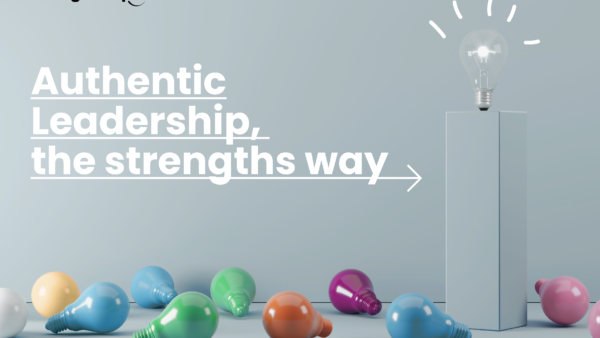What is the research telling us about strengths-based leadership?
Strengths based leadership is getting a lot of interest these days and rightly so. What we know from the research is that when leaders enable the strengths of their teams, there is a large spike in engagement (Gallup) and that this can also lead to significant increases in productivity when taken into performance management conversations (Corporate Leadership Council). So the strengths based approach – managing and leading by focusing on others’ strengths – makes a human difference and a business difference. Other findings include:
- Leaders with one or more outstanding strengths are twice as likely to be ranked in the top third in terms of effectiveness. Zenger, Folkman and Edinger, Oct 2011, Harvard Business Review
- No two leaders share the same strengths and weaknesses and attempting to mimic the strengths of another leader can’t be sustained over the long term. Rath and Conchie, 2009
- Leaders who use their strengths effectively and develop positive leadership behaviours are rated as more effective. Strengthscope research, 2017
- The chance of someone being actively disengaged when their manager plays to their strengths is 1 in 100. Gallup research
What does it mean to be a strengths based leader? Identify your highs and lows
Most importantly, a strengths based leader recognises that they have leadership strengths – unique qualities that energise them and that they are skilled at using (or have the potential to become skilled at using). Those leadership strengths will be unique to them – we know from Strengthscope research that the chances of having the same Top 7 Strengthscope strengths in the same order as anyone else is 1 in 1.3 billion, so it stands that every leader has the potential to bring unique qualities into their leadership role.
Strengths based leaders also know that they have vulnerabilities – specifically, the potential for their strengths to go into overdrive and to have areas of non-strength which drain them – potential leadership weaknesses if you like. More on that a little later.
So what role do leadership competencies have?
In a world still geared towards all employees meeting competency requirements, that recognition that the strengths based leader has highs and lows instantly marks them out as different from a leader striving to be well rounded, to meet each and every competency requirement laid down by their employer as their sole aim.
When you know your strengths and your risks as a leader, you better understand how to achieve competency standards in a way which is more energising, and less draining or risky for you, rather than feeling you’re going to need to twist yourself into all sorts of shapes to meet the competency requirements of your employer.
Making space for others to flourish
There are other benefits – as a leader if you acknowledge you have vulnerabilities, that you’re not great at everything – that means there will be space for others to stretch and develop and grow because you will need their skills and strengths to support your aims. And you won’t try to do everything on your own. You’re much more likely to need and learn the art of delegation and partnering because you know that you simply don’t have the strength to do everything and anything. And you’re ok with that.
Stepping into your unique brand of leadership
The biggest benefit though is that by identifying where you do have strengths, you can work on your own brand of leadership and in time, you can become a master of that like no one else can. Literally. It’s a career’s worth of work to do that – if I look at my standout 3 strengths of Collaboration, Empathy and Leading, I need to remember to walk the line every day between relationship building, being part of a team and enjoying that collegiality and togetherness, listening to and understanding others’ challenges and supporting them on their journeys (that’s the Empathy). And I need to combine that with providing clear, inspiring leadership for everyone by communicating the vision, clarity on direction and purpose and holding people to account for delivery (that’s the Leading).
I have to dig deep for the holding to account. I need preparation to give constructive feedback well – it’s not natural for me, but I use my Empathy to remember that people value honesty and clarity. I use others’ Efficiency to follow processes we have for feedback through our performance management process and I use my Critical thinking to prepare exactly what I want to say before I go into a “courageous conversation” type meeting.
Five tips for effective strengths based leadership
Strength based leadership is about being self-aware, being real, authentic, being prepared to be vulnerable, to make mistakes, to own those mistakes, to be human and to own that. And it also means being comfortable with the idea that no one will lead like you, stepping into that space with confidence and making the impact that you want to make.
So what can you do to increase the extent to which you lead with strengths in your leadership role? How can you become a more effective leader, through strengths based leadership? Five things:
1. Use your strengths
Firstly, know and remember your strengths and use them every day. Exercise them, become familiar with them, talk to others about them, stretch them. Actively work on your leadership brand so that your stakeholders, your colleagues, your team, your customers, know who you are as a leader – what drives you, your values, your strengths, what should they come to you for, why should they be led by you. Have a listen to my podcasts at Seasons 1, episodes 11-12 on how to build your personal brand (part 1 and part 2).
2. Limit your risks
Second, to become a more effective leader, become more aware of your risk areas – where are your overdrive risks? What drains you? And what, actively, will you do about each?
I know that sometimes my Optimism and Strategic mindedness strengths can combine and overdrive and that might lead me to get complacent about a plan or a project when I should be checking in more regularly and making sure things are on track (that’s a leadership overdrive risk). I know also that I need to rely on others for processes and project plans that I should be following because Efficiency and planning drain me (so that’s a drainer, a potential leadership weakness, a vulnerability – others know it and that’s ok).
3. Get feedback
Third, ask for feedback from colleagues on where they see your strengths, when they see you come alive and be at your very best. If you’re using Strengthscope, the 360 and leader modules make this process easy but even when using those and definitely if not using them, actively asking your colleagues for feedback on where they see you at your strongest can be enlightening, reassuring and sometimes surprising, so go get the feedback.
4. Develop effective leadership behaviours
Fourth, and there’s more, much more on this to share, develop effective leadership behaviour. The strengths-based leadership model we’ve developed, integrated into our strengths based leadership profiler StrengthscopeLeader™ includes to share vision, spark engagement, skilfully execute and sustain progress. Strengths knowledge and application aren’t enough, to get the most from your strengths, you need to cultivate positive leadership behaviours too.
5. Help others play to their strengths
And finally, once you’re on your own strengths development journey, you can best enable other people’s strengths. There’s more on this topic at my podcast on Maximising strengths in others – the art of great leadership at Season 5, episode 11.
If you’re interested in a broader perspective on leadership, please take a listen to my podcast on The future of leadership at Season 8, episode 1. Thanks for listening today. If you liked today’s podcast, please subscribe on your favourite platform using the button below – when more people subscribe, the podcast gets more visible and more people get to listen and I’m really keen to share more widely.
So please give me a subscribe click. Thank you. Till next time, stay strong.
You can find this podcast on Apple podcasts, Spotify, Google podcasts, Stitcher, ACast, TuneIn, Breaker and Soundcloud. Please support it by subscribing to get it at the start of the working week!









